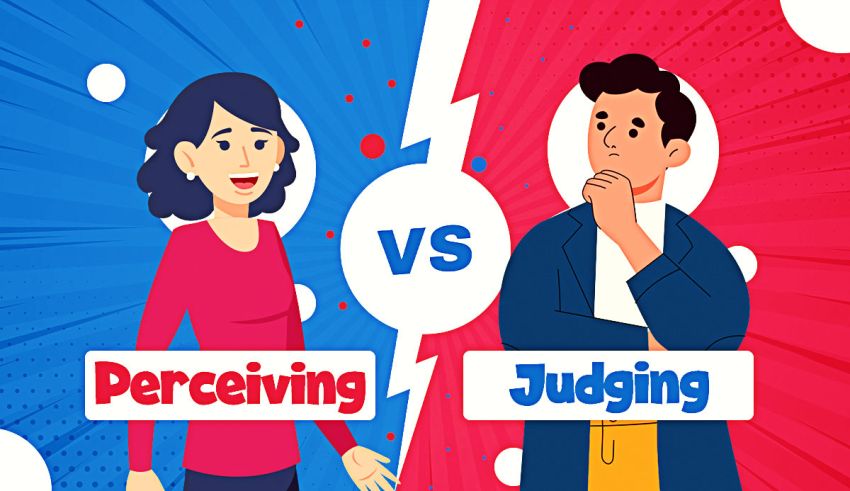You may find out if the final letter of your MBTI type is J or P by taking the Judging vs. Perceiving Test. If you’re wondering if you’re judging or observing something, try it out.
A Judging vs. Perceiving Test: What Is It?
The final dichotomies of one’s Myer-Briggs personality type are the topic of this personality test. The Judging vs. Perceiving Test, which is designed in a self-report format, enables participants to determine whether their MBTI type ends in J or P.
You can also take the Thinking vs. Feeling Test for a more thorough evaluation. It might reveal whether you are Te-Fi or Fe-Ti.
What distinguishes it from the MBTI test?
The Myer-Briggs Type Indicator test examines every facet of your personality to divide you into one of 16 categories. The Judging vs. Perceiving Test, however, is more narrowly focused on mental processes.
Definition of a Judge
A judging person, often referred to as a judger or J, is someone who prioritizes decision-making, wants a sense of control in daily life, completes all tasks before to the deadline, and can only have fun when the work is completed.
Judges demonstrate their capacity for making judgments and can be either Thinking or Feeling. They may appear to be goal- or action-oriented as well as driven by nature.
A Perceiving Person’s Definition
A Perceiving person, also known as a Perceiver or P, is an adaptable and spontaneous person who can juggle work and play, doesn’t feel the need to control everything, values acquiring knowledge above making snap judgments, and can go with the flow.
The two situations where perceivers are most likely to use their information-gathering skills are in social settings and during situational analysis.
How the Test Operates
The Judging vs. Perceiving Test determines which of the ultimate MBTI dichotomies (i.e., J or P) you possess by analyzing your mental processes in fictitious settings and understanding your judging axes.
In contrast to other personality tests like the Enneagram Test, it takes into account particular facets of your personality to get findings.
The test’s primary purposes include the following.
- a description of your thought processes.
- evaluating how your decisions compare to those of other participants.
- figuring out whether your personality is introverted or extrovert.
What Motivates Judgement vs. Perception of Personalities?
The difference between Judging and Perceiving personalities is best explained by Frank James, a well-known YouTuber who specializes in MBTI-related content. He says: “Because the Judging functions are more active, if you are a Judging type, that means that you have extraverted Thinking or Feeling, which theoretically means that you are more apt and more likely to take action in the real world. Meanwhile. Being a perceiving type, your first extroverted function will either be extroverted intuition or extroverted sensing, which are perceiving functions and aren’t particularly about acting in the environment. They focus more on information collection.
Three elements that influence test results
The Judging vs. Perceiving Test evaluates three crucial aspects to effectively identify your type. It examines your managing abilities and generates a P or J profile in line with that.
pattern of decision-making.
Perceivers typically take their time making decisions. They tend to gather as much information as possible before closure or conclusion. Judges, however, place a priority on closure and work to make rulings fast.
In order to examine your decision-making patterns indirectly, the Judging vs. Perceiving Test offers questions.
management of time.
The test includes specific questions to help you determine which end of the spectrum, based on how you perceive time, you lean towards.
J people think that time is a controllable resource. They therefore think through every step, concentrate on the most crucial duties, and finish everything before the deadlines. P people, on the other hand, believe that time is a fluid idea that should be learned to flow with rather than bend.
Lifestyle.
When contrasting their lifestyles, a Judger and a Perceiver’s differences become more obvious. In order to improve the results, the exam takes a broad view of numerous facets of your daily life.
Please take note that you are not required to answer any personal questions or give us any sensitive data.
Before taking the judgment vs. perception test, read here.
It’s not a good idea to categorize people based on their personality dichotomies. So, before beginning the quiz, we want you to bear two things in mind.
#1. Your MBTI type is not determined by judging axes.
The Judging vs. Perceiving Test results cannot be used to determine a person’s Myer-Briggs type. The outcomes should only be viewed as educated guesses for the “last letter” in your type. (For instance, the J in INFJ.)
Second, judging is not judging, and perceiving is not perceiving.
It is incorrect to infer that P or J persons are sensitive or disapproving.
The terms allude to your cognitive processes. Therefore, thinking or feeling functions are more likely to be present in a J personality. Additionally, P type people may have sensing or intuition functions.
Disclaimer
The people and organizations mentioned in the Judging vs. Perceiving Test are not affiliated with QuizExpo. No copyright violation is intended because the questionnaire was independently produced.
For more personality quizzes check this: Which Mlb Hall Of Famer Are You Quiz.





